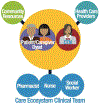The Role of Care Navigators Working with People with Dementia and Their Caregivers
- PMID: 31322558
- PMCID: PMC7004209
- DOI: 10.3233/JAD-180957
The Role of Care Navigators Working with People with Dementia and Their Caregivers
Abstract
Background: Care navigation is an approach to personalized care management and care coordination that can help overcome barriers to care. Care navigation has not been extensively studied in dementia, where health care workforce innovations are needed as a result of increasing disease prevalence and resulting costs to the health care system.
Objective: To identify facilitators and barriers to care navigation in dementia and to assess dementia caregiver satisfaction with care navigation.
Methods: Methods include qualitative research (interviews, focus groups, observations) with "Care Team Navigators" (CTNs) who were part of a dementia care navigation program, the Care Ecosystem, and a quantitative survey with caregivers about their experiences with CTNs. Transcripts were analyzed to identify themes within the data.
Results: CTNs identified the following facilitators to care navigation in dementia: working closely with caregivers; providing emotional support; tailoring education and resources; and coordinating with a clinical team around issues ranging from clinical questions to financial and legal decision-making. The barriers CTNS identified included burn-out, the progressive nature of the disease; coordinating with primary care providers; and identifying resources for dyads who are low-income, do not speak English, or live in rural areas. Caregivers across both sites highly rated CTNs, though satisfaction was higher among those in Nebraska and Iowa.
Conclusions: Innovative approaches to care delivery in dementia are crucial. Care navigation offers a feasible model to train unlicensed people to deliver care as a way to deliver larger-scale support for the growing population of adults living with dementia and their caregivers.
Keywords: Care navigation; caregivers; dementia; health care workforce.
Conflict of interest statement
Conflicts of Interest:
References
-
- Dohan D, Schrag D (2005) Using navigators to improve care of underserved patients: Current practices and approaches. Cancer 104, 848–855. - PubMed
-
- Esparza A (2013) Patient navigation and the american cancer society. Semin. Oncol. Nurs. 29, 91–96. - PubMed
-
- Ko NY, Darnell JS, Calhoun E, Freund KM, Wells KJ, Shapiro CL, Dudley DJ, Patierno SR, Fiscella K, Raich P, Battaglia TA (2014) Can patient navigation improve receipt of recommended breast cancer care? Evidence from the national Patient Navigation Research Program. J. Clin. Oncol. 32, 2758–2764. - PMC - PubMed


